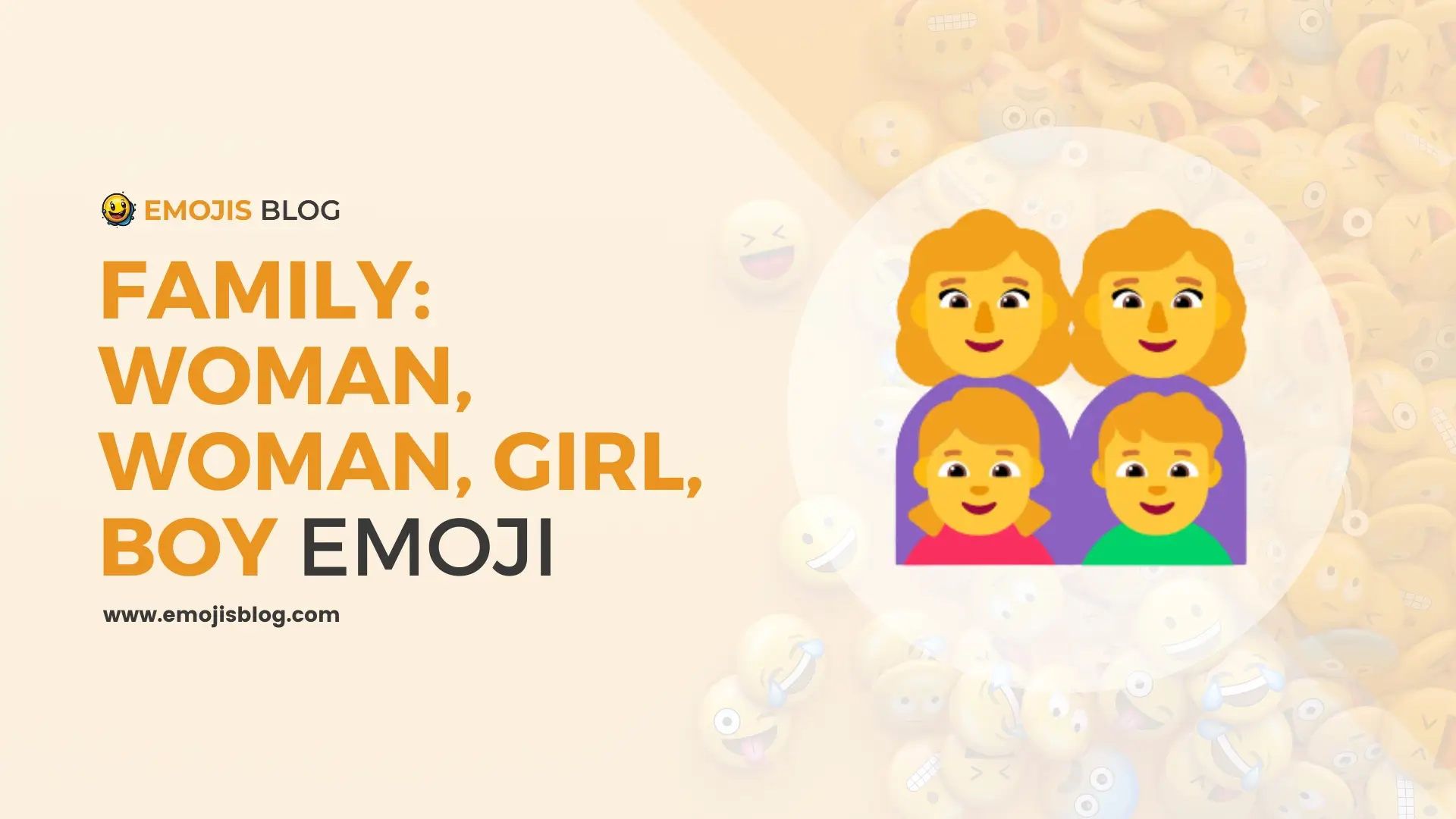Family: Woman, Woman, Girl, Boy Emoji 👩👩👧👦 Meanings
👩👩👧👦
Family: Woman, Woman, Girl, Boy Emoji 👩👩👧👦 Meanings
The Family: Woman, Woman, Girl, Boy emoji (👩👩👧👦) represents a family unit consisting of two women, a girl, and a boy, symbolizing a same-sex female couple with two children. This emoji promotes inclusivity and recognition of diverse family structures, allowing individuals from such families to represent themselves accurately in digital communication. By integrating this emoji, platforms aim to reflect the reality of modern families and support the normalization and acceptance of LGBTQ+ families in society.
Technical Information
| Attribute | Details |
|---|---|
| Emoji | 👩👩👧👦 |
| Unicode Name | Family: Woman, Woman, Girl, Boy |
| Codepoints | U+1F469, U+200D, U+1F469, U+200D, U+1F467, U+200D, U+1F466 |
| Introduced in | Unicode 7.0 |
| Unicode Version | 6.0 (initially for individual emojis), ZWJ sequence introduced in 7.0 |
| Shortcode | :family_woman_woman_girl_boy: |
| Display Sequence | 👩👩👧👦 (combination of 👩 Woman, 👩 Woman, 👧 Girl, 👦 Boy with Zero Width Joiners) |
| Category | People & Body |
| Subcategory | Family |
| Related Emojis | 👨👨👧👦, 👩👩👦👦, 👨👨👦👦, 👩👩👧👧 |
| Variations | Dependent on platform, may have slight design differences |
Understanding the Family: Woman, Woman, Girl, Boy Emoji 👩👩👧👦
The Family: Woman, Woman, Girl, Boy emoji, represented as 👩👩👧👦, is a symbolic representation of a family structure in the digital world. It conveys the concept of a family unit consisting of two women, one girl, and one boy. This emoji is a part of the broader range of family emojis available across various digital platforms, which aim to represent different family dynamics and structures.
Origins and Evolution of Family Emojis
Emojis have become an integral part of digital communication, evolving from simple smiley faces to a diverse array of symbols that represent a wide range of emotions, objects, and social concepts. The family emojis were introduced to provide more inclusive and representative options for users to depict their family units.
Initially, family emojis were limited to the traditional nuclear family structure: a man, a woman, and one or two children. However, as societal understanding and acceptance of diverse family configurations grew, so did the need for more inclusive emojis. The Family: Woman, Woman, Girl, Boy emoji is one of many that cater to this inclusivity.
Representation and Inclusivity
The Family: Woman, Woman, Girl, Boy emoji specifically represents a same-sex female couple with two children – a girl and a boy. This emoji holds significant value as it acknowledges and validates the existence of same-sex families. It provides a visual means for individuals in such family structures to represent themselves accurately in digital communications.
Inclusivity in emojis is crucial as it helps normalize diverse family arrangements, promoting acceptance and understanding. By including emojis like 👩👩👧👦, platforms like Apple, Google, and Facebook aim to reflect the reality of modern families and ensure everyone feels seen and represented.
Usage in Digital Communication
Emojis are used to enhance text communication, adding emotional depth and clarity to messages. The Family: Woman, Woman, Girl, Boy emoji can be used in various contexts, such as:
- Personal Identification: Individuals from similar family structures might use this emoji to represent their own families in texts, social media posts, and other digital interactions.
- Celebrations and Events: It can be used to celebrate family-related events such as birthdays, anniversaries, and holidays, emphasizing the unique makeup of the family.
- Advocacy and Awareness: This emoji can also be employed in conversations about LGBTQ+ rights, family diversity, and inclusivity, helping to promote awareness and support for same-sex families.
Technical Aspects and Variations
The Family: Woman, Woman, Girl, Boy emoji is created by combining individual emojis representing women, a girl, and a boy using a Zero Width Joiner (ZWJ). This technical mechanism ensures that the individual emojis are displayed as a single cohesive unit, symbolizing the family structure.
Different platforms might render this emoji slightly differently, but the core concept remains the same. Variations might include differences in the design and appearance of the characters, but the representation of a same-sex female couple with two children is consistent.
The Broader Impact of Inclusive Emojis
The inclusion of diverse family emojis like 👩👩👧👦 in digital communication tools reflects broader societal shifts towards acceptance and recognition of diverse family structures. It plays a role in:
- Normalizing Diversity: By representing a wide range of family configurations, emojis help normalize the diversity seen in real-world families, promoting greater acceptance.
- Encouraging Representation: People are more likely to feel valued and understood when they see their lives and experiences represented in the tools they use daily.
- Fostering Inclusivity: Inclusive emojis contribute to creating a more inclusive digital environment where everyone can find symbols that resonate with their personal experiences.
Conclusion
The Family: Woman, Woman, Girl, Boy emoji is a powerful symbol of inclusivity and representation in the digital world. It allows same-sex female couples with children to see themselves reflected in the emojis they use, promoting acceptance and normalization of diverse family structures. As digital communication continues to evolve, the importance of such inclusive symbols cannot be overstated. They not only enrich our conversations but also contribute to a more inclusive and accepting society.

